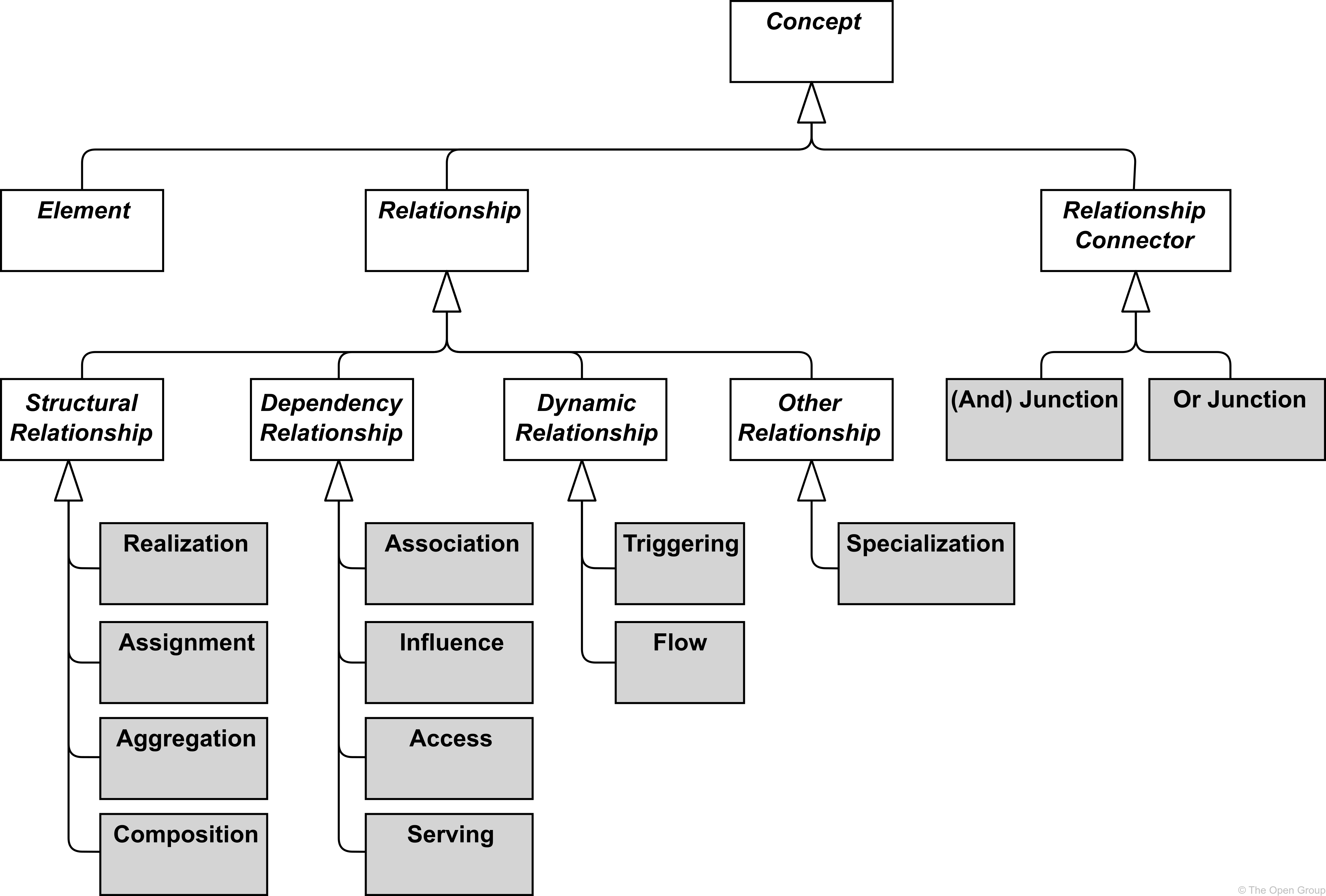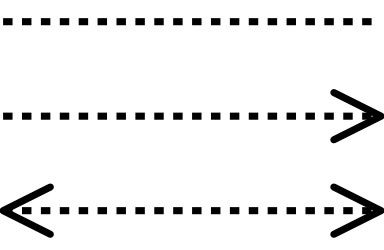Introduction
In the intricate realm of enterprise architecture, the ArchiMate language serves as a powerful tool for modeling and visualizing the structure and behavior of complex systems. Central to this modeling language are relationships and relationship connectors, fundamental components that define the connections between various architectural elements. Understanding the nuances of these relationships is crucial for creating accurate and meaningful architectural representations.

Classification of Relationships
The relationships in ArchiMate can be broadly classified into four categories: structural relationships, dependency relationships, dynamic relationships, and other relationships. This classification is illustrated in the Figure above, providing a comprehensive overview of the connections that can be established within an architectural model.
- Structural Relationships: Structural relationships are employed to model the static construction or composition of concepts. These connections can exist between elements of the same or different types. Notably, some relationships in this category are “overloaded,” implying that their meaning varies based on the types of elements they connect.
- Dependency Relationships: Dependency relationships articulate how elements are utilized to support other elements. This category captures the dependencies that underpin the architecture, showcasing how certain elements rely on others for their functionality or existence.
- Dynamic Relationships: Dynamic relationships come into play when modeling behavioral dependencies between elements. In the dynamic realm of enterprise architecture, these relationships illuminate how elements interact and depend on each other during various stages of system operation.
- Other Relationships: Relationships that don’t fit neatly into the above categories are grouped under “Other Relationships.” These connections might have unique characteristics that distinguish them from the more conventional structural, dependency, or dynamic relationships.
Summary of ArchiMate Relationships
Here’s a concise summary of ArchiMate relationships based on the information provided:
| Structural Relationships | Notation | Role Names | |
|---|---|---|---|
| Composition | Represents that an element consists of one or more other concepts. | 
|
→ composed of
← composed in |
| Aggregation | Represents that an element combines one or more other concepts. | 
|
→ aggregates
← aggregated in |
| Assignment | Represents the allocation of responsibility, performance of behavior, storage, or execution. | 
|
→ assigned to
← has assigned |
| Realization | Represents that an element plays a critical role in the creation, achievement, sustenance, or operation of a more abstract element. | 
|
→ realizes
← realized by |
| Dependency Relationships | Notation | Role Names | |
| Serving | Represents that an element provides its functionality to another element. | 
|
→ serves
← served by |
| Access | Represents the ability of behavior and active structure elements to observe or act upon passive structure elements. | 
|
→ accesses
← accessed by |
| Influence | Represents that an element affects the implementation or achievement of some motivation element. | 
|
→ influences
← influenced by |
| Association | Represents an unspecified relationship, or one that is not represented by another ArchiMate relationship. | 
|
associated with
→ associated to ← associated from |
Key Constraints and Guidelines
For clarity and precision, ArchiMate imposes certain constraints and guidelines on the use of relationships and relationship connectors:
- No Relationships Between Relationships: ArchiMate explicitly prohibits relationships between two relationships. This constraint ensures a clear hierarchy and prevents ambiguity in the architectural model.
- Consistency in Relationship Connectors: When using relationship connectors, all connected relationships must be of the same type. This ensures a cohesive and logical structure within the architectural representation.
- Valid Chains of Relationships: A chain of relationships connecting two elements, facilitated by relationship connectors, is valid only if a direct relationship of the same type between those two elements is also valid. This ensures a coherent and meaningful connection between elements.
- Aggregation, Composition, and Association Constraints: Relationships connecting an element with a second relationship are limited to aggregation, composition, or association. Moreover, aggregation or composition is valid only from a composite element to the second relationship.
- Explicit Naming for Clarity: It is considered good practice to explicitly name or label relationships to avoid ambiguity or misunderstanding. Clear nomenclature enhances the interpretability of architectural models.
Permitted Relationships and Derivation Rules
The metamodel figures in ArchiMate documentation might not explicitly show all possible relationships for the sake of readability. However, ArchiMate Manual (Section 5.7) introduces a set of derivation rules to derive indirect relationships between elements in a model. This ensures that even if not explicitly stated, relationships can be logically inferred based on the defined rules.
Conclusion
Relationships and relationship connectors in ArchiMate form the backbone of effective enterprise architecture modeling. Adhering to the classification, constraints, and guidelines ensures that architectural representations are not only accurate but also interpretable by stakeholders. As enterprises evolve, the ability to model and analyze relationships becomes increasingly crucial in maintaining a resilient and adaptive architectural framework. ArchiMate, with its robust set of relationship constructs, provides architects with the tools needed to navigate the complexities of modern systems and design architectures that stand the test of time.
A Solid Choice for Enterprise Architecture (EA) Modeling
Visual Paradigm is indeed a solid choice for Enterprise Architecture (EA) modeling, and here are a few reasons why it’s often recommended:
Comprehensive Toolset:
Visual Paradigm provides a comprehensive set of tools for EA modeling. It covers a wide range of modeling needs, including business process modeling, system architecture modeling, data modeling, and more. The versatility of the tool makes it suitable for various aspects of enterprise architecture.
ArchiMate Support:
Given the context of ArchiMate language in your previous input, Visual Paradigm’s support for ArchiMate is noteworthy. It allows users to create ArchiMate diagrams seamlessly, aligning with the standardized modeling language for enterprise architecture.
User-Friendly Interface:
Visual Paradigm features an intuitive and user-friendly interface. This is crucial for effective modeling, as it ensures that architects and stakeholders can easily navigate through the tool, accelerating the modeling process and making it accessible to users with varying levels of expertise.
Collaboration and Teamwork:
Effective collaboration is vital in enterprise architecture, and Visual Paradigm excels in this aspect. It offers collaborative features that enable teams to work on the same project concurrently, facilitating real-time collaboration and communication.
Integration Capabilities:
Visual Paradigm supports integration with other popular tools and platforms, enhancing its compatibility with your existing technology stack. Integration with version control systems and issue tracking tools streamlines the development and maintenance of architectural models.
Documentation and Reporting:
Enterprise architecture often involves detailed documentation. Visual Paradigm provides robust documentation and reporting features, allowing users to generate documentation directly from the models. This is valuable for communication with stakeholders and maintaining a comprehensive record of architectural decisions.
Regular Updates and Support:
The tool is regularly updated to keep up with industry standards and user needs. Visual Paradigm also offers good customer support, providing assistance when users encounter challenges or have specific inquiries.
Educational Resources:
For users looking to enhance their skills or learn more about enterprise architecture modeling, Visual Paradigm offers educational resources, including tutorials and documentation. This support is beneficial for both beginners and experienced architects.
Cost-Effective Options:
Visual Paradigm provides various licensing options, including student licenses and community editions for smaller projects. This flexibility makes it a cost-effective choice for individuals, educational institutions, and enterprises of different sizes.
Visual Paradigm stands out as a preferred choice for EA modeling due to its comprehensive feature set, ArchiMate support, user-friendly interface, collaboration capabilities, integration options, strong documentation features, regular updates, and accessible educational resources. When considering an EA modeling tool, it’s essential to evaluate how well it aligns with your specific needs and workflows, and Visual Paradigm often meets these criteria effectively.
Resources
- Introduction: ArchiMate® 3.2 Specification
- Free Online ArchiMate Tool + Examples – Cybermedian
- What is ArchiMate?
- ArchiMate – Wikipedia
- The ArchiMate® Enterprise Architecture Modeling Language | www.opengroup.org
- An Overview of ArchiMate – the Enterprise Architecture Modeling Language – Cybermedian
- Comprehensive Tutorial on ArchiMate – Visual Paradigm Guides
- A. Summary of Language Notation : ArchiMate
- Comprehensive Guide to the 14 UML Diagram Types – Cybermedian
- Navigating TOGAF: Your Guide to the ADM Process – Visual Paradigm Guides
- TOGAF | www.opengroup.org
- TOGAF ADM Automated Workflow Management – Cybermedian
- The Open Group Architecture Framework – Wikipedia
- Chapter 31. TOGAF ADM Guide-Through – Visual Paradigm Community Circle
- TOGAF® Standard — Introduction – Introduction
- Introduction to TOGAF Architecture Development Method (ADM) – Cybermedian
- TOGAF® Tool for Enterprise Architecture – ArchiMetric
- A Practical Tutorial for TOGAF
- The TOGAF® Standard, Version 9.2